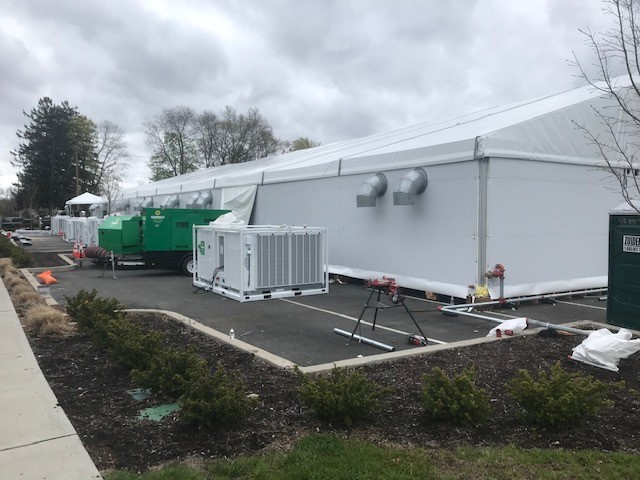A new temporary medical facility, comprising two fully-equipped tents, was completed in just two weeks at Bergen New Bridge Medical Center (BNBMC) in Paramus, N.J. The project was built by Holt Construction, the U.S. Army Corps of Engineers, and FEMA.
The hospital is a first of its kind for Army Corps temporary facility construction standards and will serve as a treatment facility for acute, non-COVID related patients due to the influx of COVID-positive patients in the main building. Located in a large parking lot adjacent to BNBMC's main building, the temporary hospital will serve an additional 100 patients in total.
Each tent includes 50 patient beds as well as an admissions bay, nurse stations, six bathrooms with showers, hospital staff nourishment and support areas, a nurse call system in each patient room, medical gas storage, medicine storage, and soiled holding. Life safety provisions, such as fire alarm, sprinkler, fire extinguishers, and other life-safety systems, were also installed. Plumbing and sprinkler were run from the main building to the lot and new incoming primary power with a stepdown transformer was provided to power the two tents.
See Also: Danish hospital is constructed from 24 steel frame modules
The tents were constructed by over 80 carpenters, 20 electricians, and 20 plumbers working in three shifts around the clock. Social distancing was enforced at all times and all personnel were equipped with N95 face masks, face shields, gloves, and goggles. Additionally, sanitation stations were set up for use upon entering and exiting the site.

Related Stories
| Oct 30, 2014
CannonDesign releases guide for specifying flooring in healthcare settings
The new report, "Flooring Applications in Healthcare Settings," compares and contrasts different flooring types in the context of parameters such as health and safety impact, design and operational issues, environmental considerations, economics, and product options.
| Oct 30, 2014
Perkins Eastman and Lee, Burkhart, Liu to merge practices
The merger will significantly build upon the established practices—particularly healthcare—of both firms and diversify their combined expertise, particularly on the West Coast.
| Oct 21, 2014
Passive House concept gains momentum in apartment design
Passive House, an ultra-efficient building standard that originated in Germany, has been used for single-family homes since its inception in 1990. Only recently has the concept made its way into the U.S. commercial buildings market.
| Oct 21, 2014
Hartford Hospital plans $150 million expansion for Bone and Joint Institute
The bright-white structures will feature a curvilinear form, mimicking bones and ligament.
| Oct 16, 2014
Perkins+Will white paper examines alternatives to flame retardant building materials
The white paper includes a list of 193 flame retardants, including 29 discovered in building and household products, 50 found in the indoor environment, and 33 in human blood, milk, and tissues.
| Oct 15, 2014
Harvard launches ‘design-centric’ center for green buildings and cities
The impetus behind Harvard's Center for Green Buildings and Cities is what the design school’s dean, Mohsen Mostafavi, describes as a “rapidly urbanizing global economy,” in which cities are building new structures “on a massive scale.”
| Oct 13, 2014
Debunking the 5 myths of health data and sustainable design
The path to more extensive use of health data in green building is blocked by certain myths that have to be debunked before such data can be successfully incorporated into the project delivery process.
| Oct 12, 2014
AIA 2030 commitment: Five years on, are we any closer to net-zero?
This year marks the fifth anniversary of the American Institute of Architects’ effort to have architecture firms voluntarily pledge net-zero energy design for all their buildings by 2030.
| Oct 8, 2014
Massive ‘healthcare village’ in Nevada touted as world’s largest healthcare project
The $1.2 billion Union Village project is expected to create 12,000 permanent jobs when completed by 2024.
| Oct 3, 2014
Designing for women's health: Helping patients survive and thrive
In their quest for total wellness, women today are more savvy healthcare consumers than ever before. They expect personalized, top-notch clinical care with seamless coordination at a reasonable cost, and in a convenient location. Is that too much to ask?
















